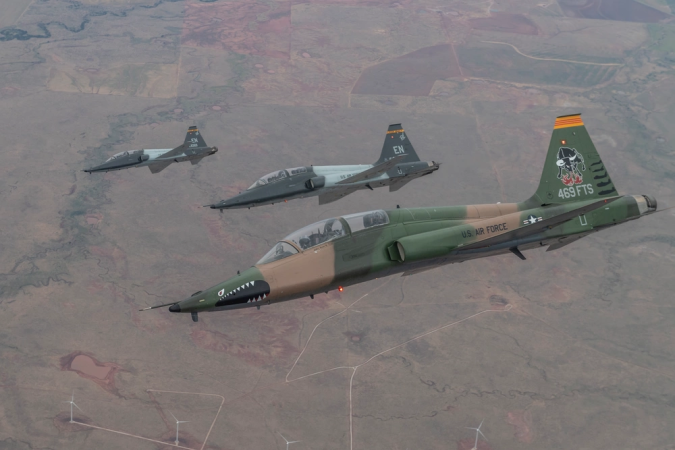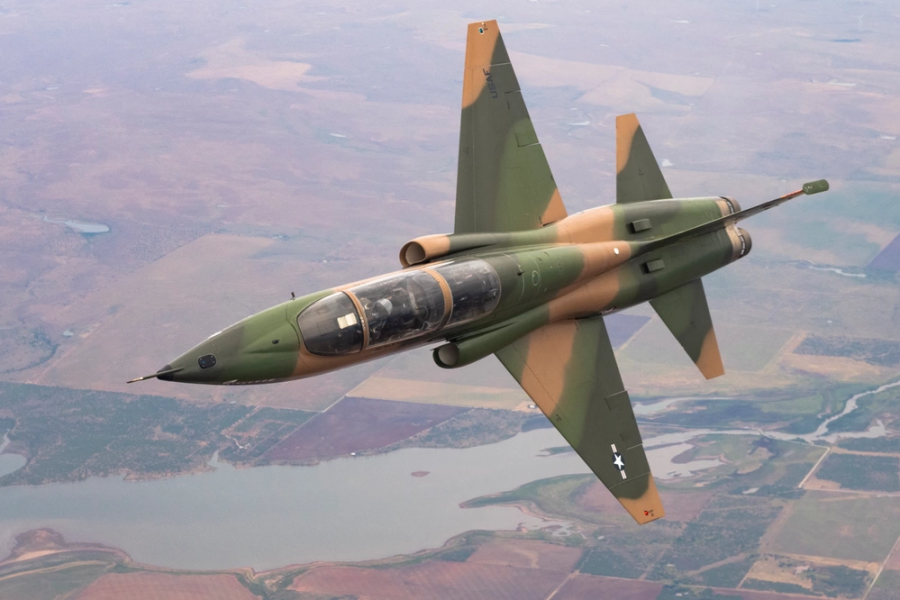They fly U.S. Air Force aircraft at a U.S. Air Force base in north Texas, but the student and instructor pilots at the Euro-NATO Joint Jet Pilot Training Program (ENJJPT) hail from more than a dozen countries across Europe and North America.
“It’s completely normal to fly with two different instructors on the same day and five different instructors through a five-day work week, and it’s completely normal for all of those instructors to be from different countries,” U.S. Air Force 1st Lt. Mark Reyes, who finished the 55-week undergraduate pilot training program at ENJJPT on Oct. 18, told Air & Space Forces Magazine recently. “It’s something that’s very unique to ENJJPT, and it’s something that I was very attracted to when coming here.”
With 207 aircraft flying about 250 missions per day, ENJJPT makes Sheppard Air Force Base, Texas, one of the busiest airfields in the Air Force. It is a pilot factory, churning out about 190 undergraduate pilot training (UPT) graduates and about 180 graduates of its Introduction to Fighter Fundamentals and Pilot Instructor Training programs every year. ENJJPT trains half of all U.S. Air Force fighter pilots and is the sole source of fighter pilot training for several NATO allies such as Belgium, Denmark, and Germany.
“What that does for freedom and strategic deterrence just can’t be understated,” said USAF Col. Jeffrey Shulman, commander of the 80th Flying Training Wing, ENJJPT’s host unit. “And it’s done here in Wichita Falls, Texas, of all places, because of the great weather and blue sky.”
Thanks to ENJJPT, some of Reyes’ earliest memories as a military aviator are forever linked to the allies he shared them with, whether it was the German instructor pilot who taught him to fly the T-38 trainer jet, or the Italian student pilot who flew his wing on their first formation solo flight.
The same goes for Reyes’ American classmate, 1st Lt. Benjamin Bayless, who snapped photos of the Grand Canyon and the Rocky Mountains from a T-6 trainer while flying his first cross-country sorties alongside about a dozen instructors and student pilots from all over Europe.
“It was just an incredible experience, and we got to do it with a smattering of NATO partners, which just really put the cherry on top,” Bayless said.
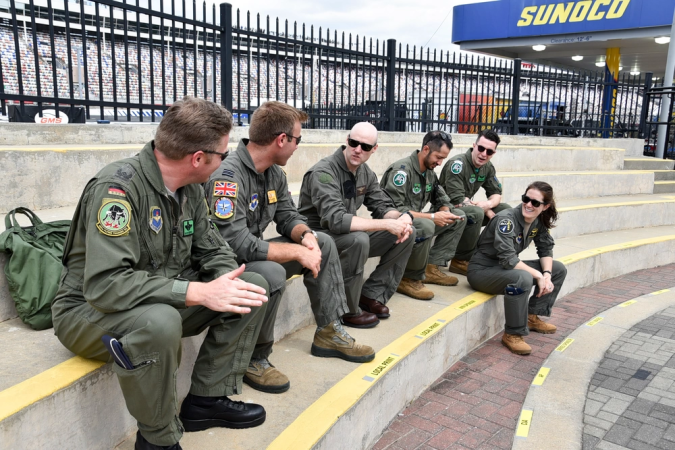
That bonding serves a strategic purpose: bringing allies closer together so they can fight well together in a future conflict, Shulman said.
“When there’s a bureaucracy roadblock and they need a quick answer, they have a friend they can call,” said the colonel, who flew F-16s over Afghanistan alongside allied pilots and in support of allied ground troops.
Shulman recalled how quickly NATO pilots had to come together for Operation Odyssey Dawn, the 2011 bombing campaign of Libya, or the air policing mission in response to Russia launching its full-scale invasion of Ukraine in 2022.
“Flying together is the easy thing, but the intangible thing about ENJJPT is the leadership that we teach here, the relationships,” he said.
Back at the Forefront
ENJJPT started almost exactly 43 years ago on Oct. 23, 1981, to improve interoperability of NATO air forces, reduce training costs, and offer an alternative training location to the cloudy skies often found over Europe. Fourteen NATO countries participate: Belgium, Canada, Denmark, Germany, Greece, Italy, the Netherlands, Norway, Portugal, Romania, Spain, Turkey, the United Kingdom, and the U.S.
“I think what a lot of people look forward to here at Sheppard is working with all the nations together,” said Lt. Col. Kevin Bourdiaudhy, the Belgian Air Force Senior National Representative at ENJJPT.
“A lot of us have worked together in exercises in Europe,” he added. “If you can come do that for three, four years in a row with this great team here at Sheppard, with a lot of blue skies, sun, and less rain than in Belgium, I think there’s a lot of motivation right there.”
More than 8,300 pilots have graduated ENJJPT’s various programs since 1981. But the program’s relevance appeared to wane in the early 2000s, according to a framed letter in Shulman’s office written in 2005 by a four-star general, who described the program as “a Cold War relic,” the colonel said.
Now, two and a half years into Russia’s full-scale invasion of Ukraine, ENJJPT seems anything but.
“I think ENJJPT is back on the forefront of importance, just based on what’s going on in the world,” Shulman said. “We’re getting a lot more attention, a lot more limelight.”
Case in point: representatives from Finland, which joined NATO in 2023, visited ENJJPT recently and flew with the Airmen there, and Shulman plans to visit Finland’s flight schools in return. That’s not to say Finland plans on joining ENJJPT, but it does indicate a growing partnership.
“It’s opening the lines of communication so we can steal ideas” from each other, the colonel said.
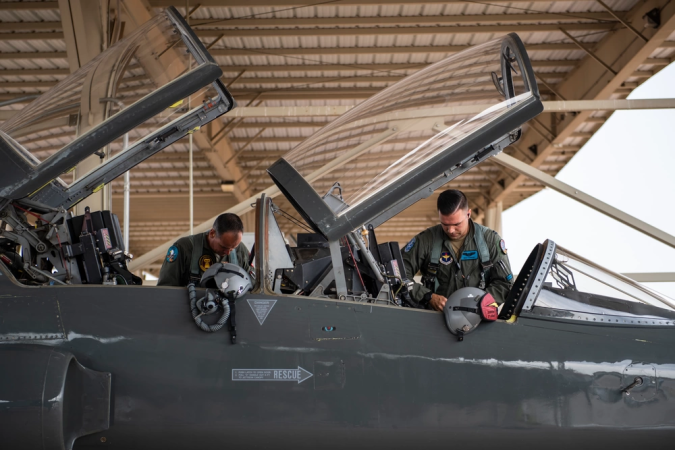
Growing Pains
Interest in ENJJPT is high, but meeting the demand of 14 nations with growing defense budgets is a challenge. Shulman said ENJJPT is operating at capacity at the moment thanks to two limiting factors: aircraft spare parts and simulator instructors.
“It’s not that I don’t have enough airplanes, I just don’t have parts to put in my airplanes,” he said.
Some of the wing’s T-38 jets were built in the early 1960s, and the average age across the fleet is about 57 years old. Aircraft availability generally declines as planes get older and factories that originally built parts shut down. In 2022, the school reduced its UPT class size from 24 students to 18 because of its contract for maintaining the J85 engine, which powers the T-38. That means it takes longer for NATO allies to put trained pilots in operational seats.
“For our partners and allies, if they don’t get one or two slots graduating, it has a massive impact on them for how they program out F-35 slots, for example,” Shulman explained.
With that in mind, U.S. Air Force officials moved the school to the front of the line in terms of J85 engine maintenance, allowing class sizes to return to 24 students in May.
“Senior Air Force leadership has recognized that we need to make sure our partners and allies have stability and predictability when they’re going to graduate their pilots,” Shulman said.
“That’s a huge win for ENJJPT,” he added. “Some of the other bases are still struggling a bit, but we’re doing pretty healthy on the T-38. It’s still a great airplane.”
That still leaves the T-6 and T-38 simulator instructor shortage, which is tough to fill when competing with juicy airline contracts.
“I need [students] to go through the simulator before they hit the airplane, and if I don’t have somebody to teach them, it kind of messes up the flow of the pipeline,” Shulman said.
Generally, if a country wants to send more students to ENJJPT, it has to send more instructors to match, Bourdiaudhy explained, but it can take a while to find experienced instructors willing to move to north Texas for a few years.
“It’s a lengthy process, but from what I’ve seen, the nations that want to increase their students are slowly bringing those instructors, and they will be able to have those slots in the future,” he said.
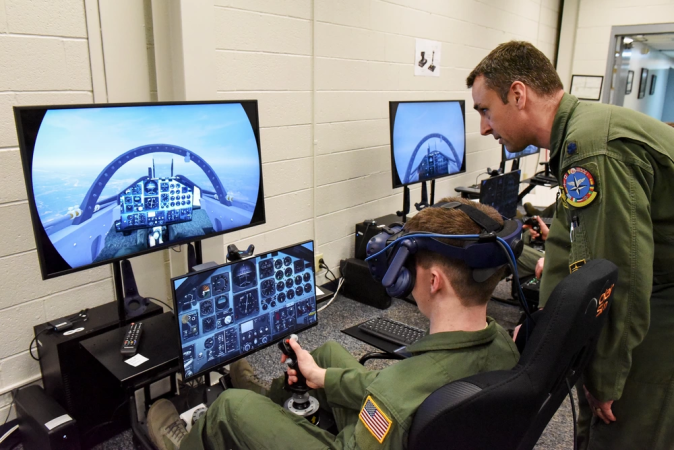
ENJJPT is trying to work smarter with its existing instructor pilot staff. In the past, the 80th FTW used a time-intensive Excel document to track their flying hours and other work metrics, which made it a challenge for Shulman to gauge where to make adjustments. But a few computer scientists at the wing came up with a user-friendly digital tool that uses artificial intelligence to give leaders a better picture of instructor resource management in real-time.
“I can really see a pulse on how hard am I working my people, which as the wing commander, that’s what I really care about; am I burning my people out, or are they not working enough,” the colonel explained.
Have Each Others’ Backs
One of U.S. Air Force Capt. James Egelston’s fondest memories at ENJJPT was an around-the-world party where students and instructors got together in a hangar to share the food and culture of their home countries.
“I haven’t been to many countries in Europe, and that made it a very special experience,” said the F-15E weapons systems officer who graduated UPT on Oct. 18 on his way to becoming an F-15C pilot.
The ENJJPT community really came together in May after instructor pilot Capt. John Robertson died when the ejection seat of his T-6 fired while the aircraft was still on the ground.
“We’re all pretty closely knit here, the students and IPs,” said Reyes. “It was awful.”
Robertson died the same day Shulman landed in Texas to take command. The colonel saw the school and the local Wichita Falls community come together, holding a memorial service, a formation flyover, and a piano burn, a fighter pilot tradition. Roberton’s unit, the 80th Operations Support Squadron, put up a small memorial for him that’s still standing.
“The team rapidly planned this within hours, and it was flawlessly executed,” Shulman said, adding that the top general of the German Air Force, himself an ENJJPT grad, wrote a condolence letter to the school.
“JR happened to be an American, but he was an ENJJPT instructor, he was no different than any other partner,” Shulman said.
For Egelston, Robertson’s death highlighted the real reason why ENJJPT is so important.
“Being a combat aviator is great and all, but what really makes the Air Force so lethal, from my perspective, is your fighter community’s ability to take care of each other and always have each other’s backs,” he said.
Bourdiaudhy made a similar point.
“When the times get rough, the solidarities are even stronger,” he said. “I saw people come together and support each other. Nations mixed in small groups, not just a few Americans there, a few Germans there, a few Belgians there. No, all mixed, all together, all in one big room.”
